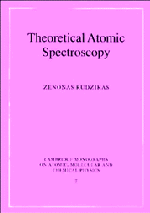Book contents
- Frontmatter
- Contents
- Preface
- Foreword to the Paperback Edition
- Introduction
- Part 1 Energy Spectrum of Many-electron Atom. Radiative and Autoionizing Transitions (Initial Formulas)
- 1 Non-relativistic atomic Hamiltonian and relativistic corrections
- 2 Relativistic atomic Hamiltonian. New wave function
- 3 Perturbation theory for the energy of an atom
- 4 Radiative and autoionizing electronic transitions. Generalized expressions for electric multipole (Ek) transition operators
- Part 2 Foundations of the Angular Momentum Theory. Graphical Methods
- Part 3 Description of Complex Electronic Configurations
- Part 4 Second-quantization in the Theory of an Atom. Quasispin and Isospin
- Part 5 Matrix Elements of the Energy Operator
- Part 6 Electric and Magnetic Multipole Transitions
- Part 7 Calculation of Energy Spectra and Electronic Transitions in the Case of Complex Configurations
- Epilogue
- References
- Index
3 - Perturbation theory for the energy of an atom
Published online by Cambridge University Press: 21 September 2009
- Frontmatter
- Contents
- Preface
- Foreword to the Paperback Edition
- Introduction
- Part 1 Energy Spectrum of Many-electron Atom. Radiative and Autoionizing Transitions (Initial Formulas)
- 1 Non-relativistic atomic Hamiltonian and relativistic corrections
- 2 Relativistic atomic Hamiltonian. New wave function
- 3 Perturbation theory for the energy of an atom
- 4 Radiative and autoionizing electronic transitions. Generalized expressions for electric multipole (Ek) transition operators
- Part 2 Foundations of the Angular Momentum Theory. Graphical Methods
- Part 3 Description of Complex Electronic Configurations
- Part 4 Second-quantization in the Theory of an Atom. Quasispin and Isospin
- Part 5 Matrix Elements of the Energy Operator
- Part 6 Electric and Magnetic Multipole Transitions
- Part 7 Calculation of Energy Spectra and Electronic Transitions in the Case of Complex Configurations
- Epilogue
- References
- Index
Summary
Methods of accounting for correlation effects
In order to improve the theoretical description of a many-body system one has to take into consideration the so-called correlation effects, i.e. to deal with the problem of accounting for the departures from the simple independent particle model, in which the electrons are assumed to move independently of each other in an average field due to the atomic nucleus and the other electrons. Making an additional assumption that this average potential is spherically symmetric we arrive at the central field concept (Hartree–Fock model), which forms the basis of the atomic shell structure and the chemical regularity of the elements. Of course, relativistic effects must also be accounted for as corrections, if they are small, or already at the very beginning starting with the relativistic Hamiltonian and relativistic wave functions.
In fact, electrons do not move independently, they ‘feel’ each other, there is a certain correlation between the electrons in their mutual Coulomb field (many-body effects).
Many-body calculations which go beyond the Hartree–Fock model can be performed in two ways, i.e. using either a variational or a perturbational procedure. There are a number of variational methods which account for correlation effects: superposition-of-configurations (or configuration interaction (CI)), random phase approximation with exchange, method of incomplete separation of variables, multi-configuration Hartree–Fock (MCHF) approach, etc. However, to date only CI and MCHF methods and some simple versions of perturbation theory are practically exploited for theoretical studies of many-electron atoms and ions.
The CI method is often based on the use of analytic functions, which form the basis set.
- Type
- Chapter
- Information
- Theoretical Atomic Spectroscopy , pp. 16 - 24Publisher: Cambridge University PressPrint publication year: 1997

